Pecharsky V.K., Zavalij P.Y. Fundamentals of Powder Diffraction and Structural Characterization of Materials
Подождите немного. Документ загружается.

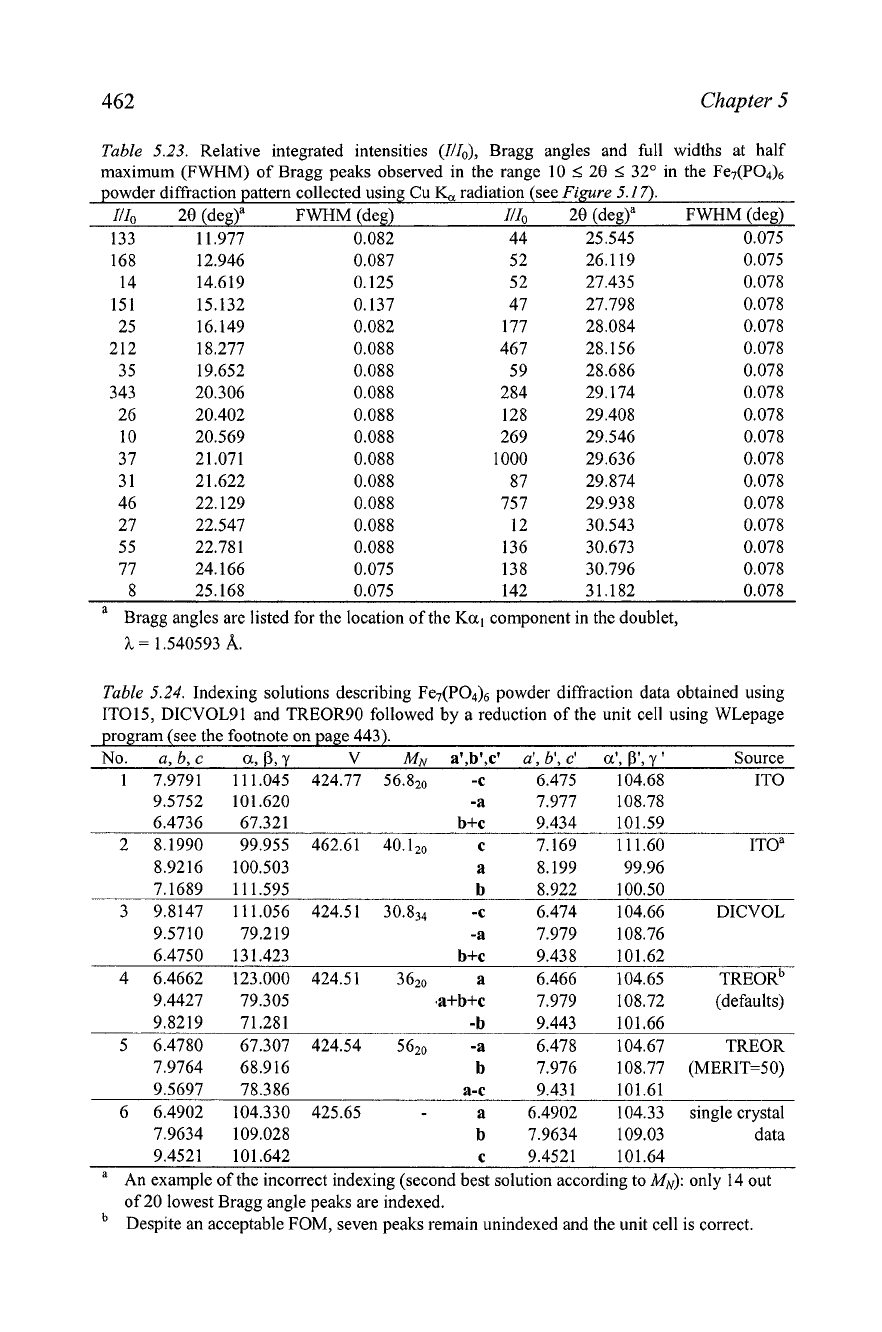
462
Chapter
5
Table
5.23.
Relative integrated intensities (III,), Bragg angles and full widths at half
maximum
(FWHM)
of Bragg peaks observed in the range 10
5
20
.5
32' in the Fe7(P04)6
powder diffraction pattern collected using Cu
K,
radiation (see
Figure
5.17).
Illo 20 (deg)a FWHM (deg) IIIo 20 (deg)" FWHM (deg)
1 1.977 0.082 44 25.545 0.075
1
1.
1
1
1
1
343 20.306 0.088 284 29.174
26 20.402 0.088 128 29.408
10 20.569 0.088 269 29.546
37 21.071 0.088 1000 29.636
3 1 21.622 0.088 87 29.874
46 22.129 0.088 757 29.938
27 22.547 0.088
12 30.543
5 5 22.781 0.088
136 30.673
77 24.166
0.075
138 30.796
8 25.168 0.075 142 31.182
a
Bragg angles are listed for the location of the
Ka,
component in the doublet,
h
=
1.540593
A.
Table
5.24.
Indexing solutions describing Fe7(P04)6 powder diffraction data obtained using
IT015, DICVOL91 and TREOR9O followed by a reduction of the unit cell using WLepage
program (see the footnote on page 443).
No.
a, b,
c
a,
p,
y
V MN
a',bf,c'
a', b',
c'
a',
(3',
y
'
Source
1 7.9791 11 1.045 424.77 56.82,
-C
6.475 104.68 IT0
9.5752 101.620
-a
7.977 108.78
8.9216 100.503
a
8.199 99.96
7.1689 111.595
b
8.922 100.50
3 9.8147 111.056 424.51 30.S34
-C
6.474 104.66 DICVOL
9.5710 79.219
-a
7.979 108.76
6.4750 13 1.423
b+c
9.438 101.62
4 6.4662 123.000 424.51 3620
a
6.466 104.65 TREOR~
9.4427 79.305
.a+b+c
7.979 108.72 (defaults)
9.8219 71.281
-b
9.443 101.66
5 6.4780 67.307 424.54 5620
-a
6.478 104.67 TREOR
7.9764 68.916
b
7.976 108.77 (MERIT=50)
9.5697 78.386
a-c
9.431 101.61
6 6.4902 104.330 425.65
a
6.4902 104.33 single crystal
7.9634 109.028
b
7.9634 109.03 data
9.4521 101.642
c
9.4521 101.64
a
An example of the incorrect indexing (second best solution according to MN): only 14 out
of 20 lowest Bragg angle peaks are indexed.
Despite an acceptable FOM, seven peaks remain unindexed and the unit cell is correct.
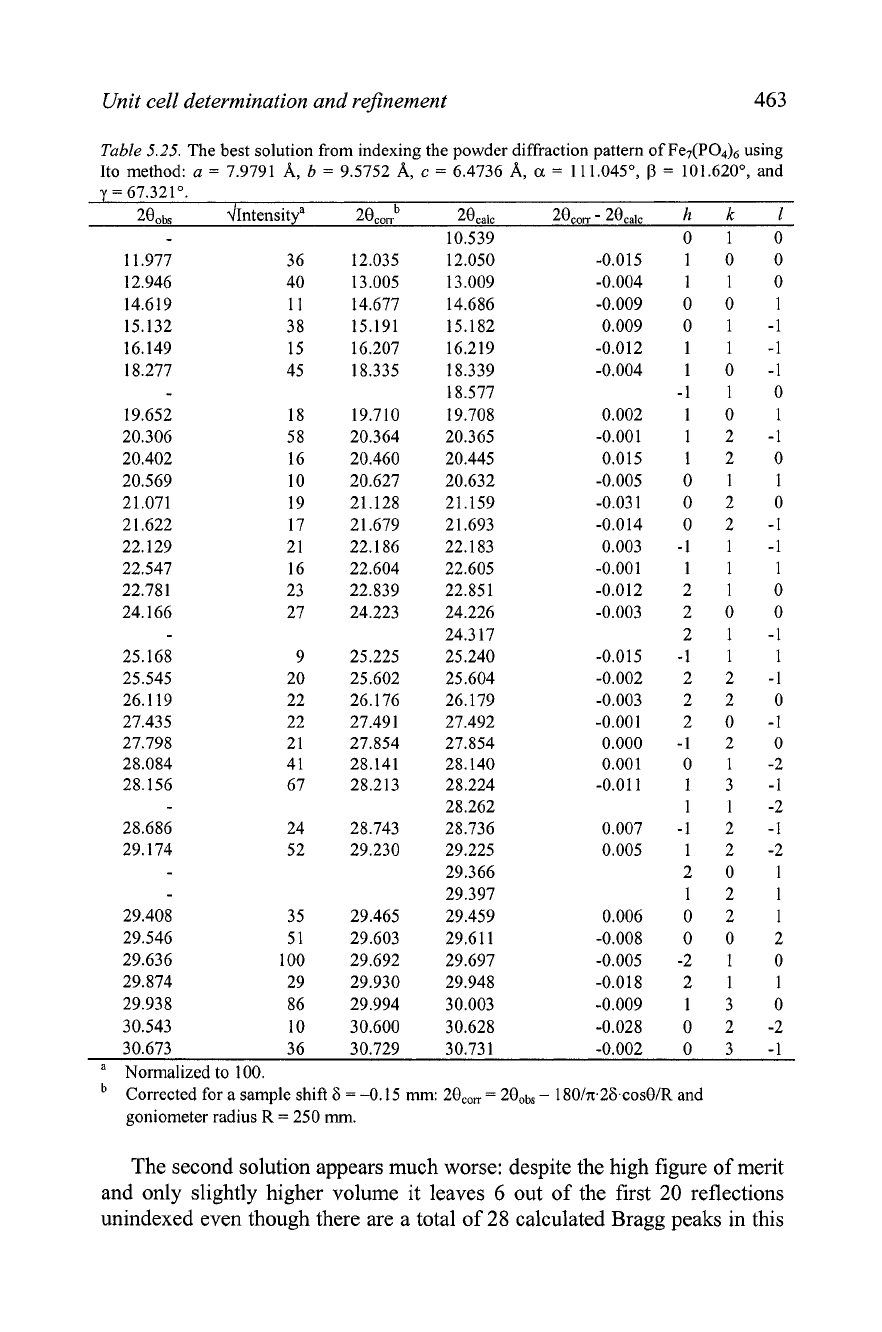
Unit cell determination and reJinement
463
Table
5.25.
The best solution from indexing the powder diffraction pattern of Fe7(P0& using
Ito method:
a
=
7.9791
A,
b
=
9.5752
A,
c
=
6.4736
A,
cc.
=
111.045",
P
=
101.620•‹, and
30.673 36 30.729 30.731 -0.002 0 3 -1
a
Normalized to 100.
Corrected for a sample shift
6
=
-0.15
mm:
20,,,
=
2Ook
-
180/n~26.cosOlR and
goniometer radius
R
=
250
mm.
The second solution appears much worse: despite the high figure of merit
and only slightly higher volume it leaves
6
out of the first
20
reflections
unindexed even though there are a total of
28
calculated Bragg peaks in this

464
Chapter
5
range of angles. Other solutions have much lower figures of merit, higher
volume and too many unindexed peaks along with a large number of
calculated Bragg reflections that are unobserved.
Some of the unreliable solutions can be eliminated by decreasing the
tolerances in
28 for zone searches. However, there is a danger of choosing a
tolerance that is too low, and by using it, the true solution can be missed. To
avoid this, the tolerance should be reduced gradually and only when
excessive amounts of different and unreliable solutions emerge.
In
our
example, the tolerance that was set by default between 3 and 4 appears to be
a good choice.
Table
5.24 also contains the results of triclinic indexing using the
DICVOL and TREOR algorithms. With all crystal systems tested, DICVOL
results in a single solution, shown in the third row. All reflections were
indexed and the figures of merit are quite high:
M34
=
30.8 and
F34
=
lO4.5(O.O08 1, 40). Employing TREOR with all parameters set to their
default value (except instruction TRIC
=
1) three solutions where found.
Two of them with unit cell volume of -800
A3
have very low figures of
merit and leave many peaks unindexed. The third one has the same cell
volume (-424
A3)
as the earlier solutions, and is listed in row 4. This
solution has 6 out of 34 Bragg reflections unindexed, which is due to the low
accuracy of the determined unit cell. To check other possible solutions, the
keyword MERIT
=
50 was inserted in the input data file. This modification
results in more than 20 different solutions with a unit cell volume of
-424
A3.
The best solution has all 34 reflections indexed, high figures of
merit, and it is listed in row
5.
As is obvious from columns 2 and 3 in
Table
5.24, different indexing
algorithms result in different choices of the unit cell for the same lattice and,
therefore, unit cell reduction is especially important to compare the results in
triclinic symmetry. The unit cell dimensions, reduced using the
WLepage
program, are listed in
Table
5.24 in columns 6-8. Obviously, all of them are
represented by the same unit cell, except the incorrect solution shown in row
2. The triclinic unit cell was confirmed by a single crystal diffraction
experiment, as shown in row 6.
5.13
Precise lattice parameters and linear least squares
After the powder diffraction pattern has been successfully indexed, the
next step is to establish the unit cell dimensions with the highest possible
precision. By combining Eqs. 5.2 and 5.3 one can see that the errors in the
lattice parameters only depend on the errors in the measured Bragg angles
assuming that Miller indices and
?L
are known exactly:
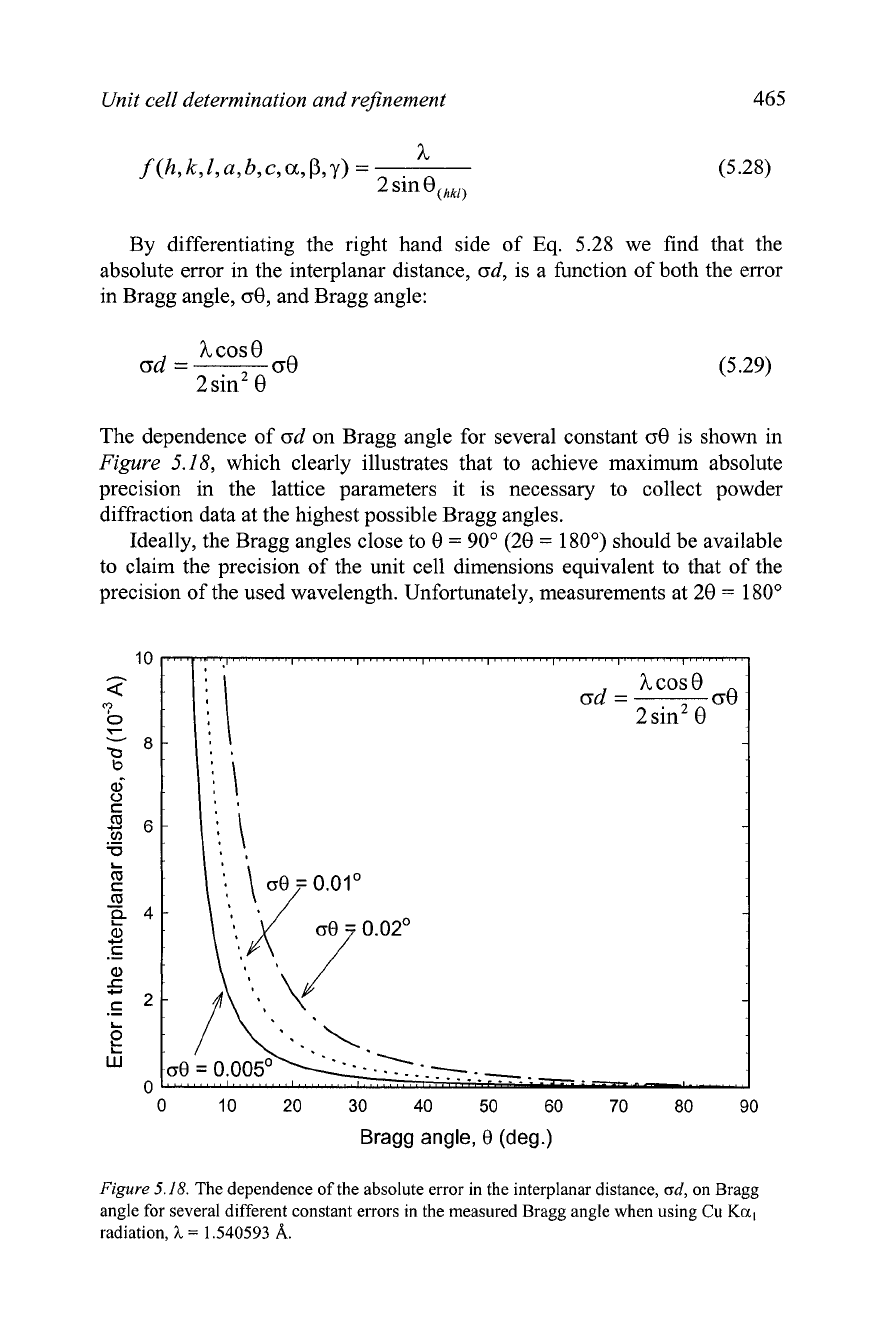
Unit cell determination and refinement
465
By differentiating the right hand side of Eq. 5.28 we find that the
absolute error in the interplanar distance, od, is a function of both the error
in Bragg angle, 08, and Bragg angle:
h
cos
0
od
=
o€l
2sin2
0
The dependence of od on Bragg angle for several constant o8 is shown in
Figure
5.18,
which clearly illustrates that to achieve maximum absolute
precision in the lattice parameters it is necessary to collect powder
diffraction data at the highest possible Bragg angles.
Ideally, the Bragg angles close to 8
=
90" (28
=
180") should be available
to claim the precision of the unit cell dimensions equivalent to that of the
precision of the used wavelength. Unfortunately, measurements at 28
=
180"
0 10 20 30 40 50 60
70
80 90
Bragg angle,
8
(deg.)
Figure
5.18.
The dependence of the absolute error in the interplanar distance,
od,
on Bragg
angle for several different constant errors in the measured Bragg angle when using
Cu
Ka,
radiation,
h
=
1
S40593
A.
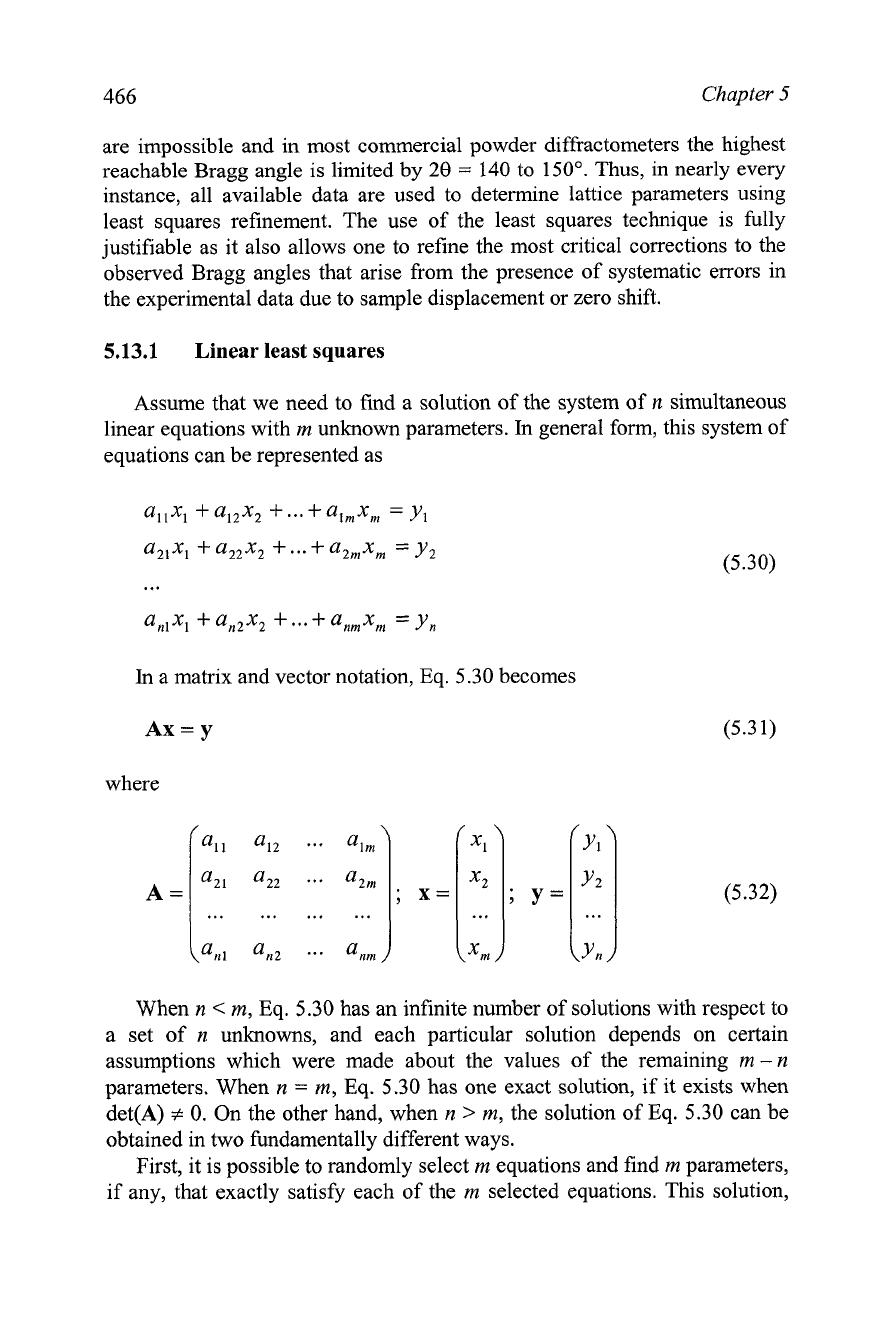
466
Chapter
5
are impossible and in most commercial powder diffractometers the highest
reachable Bragg angle is limited by
28
=
140 to 150'. Thus, in nearly every
instance, all available data are used to determine lattice parameters using
least squares refinement. The use of the least squares technique is fully
justifiable as it also allows one to refine the most critical corrections to the
observed Bragg angles that arise from the presence of systematic errors in
the experimental data due to sample displacement or zero shift.
5.13.1
Linear least squares
Assume that we need to find a solution of the system of
n
simultaneous
linear equations with m unknown parameters.
In
general form, this system of
equations can be represented as
allxl
+
a12x2
+
...
+
aImxm
=
y,
a2,xl
+
a,,x2
+
...
+
a2,x,
=
y2
.
.
.
anlxl
+
a,,x2
+...+
anmx,
=
y,
In
a matrix and vector notation, Eq.
5.30
becomes
where
When
n
<
m, Eq.
5.30
has an infinite number of solutions with respect to
a set of
n
unknowns, and each particular solution depends on certain
assumptions which were made about the values of the remaining m
-
n
parameters. When
n
=
m,
Eq.
5.30
has one exact solution, if it exists when
det(A)
+
0.
On the other hand, when
n
>
m,
the solution of Eq.
5.30
can be
obtained in two fundamentally different ways.
First, it is possible to randomly select m equations and find m parameters,
if any, that exactly satisfy each of the m selected equations. This solution,

Unit cell determination and refinement
467
however, will likely be far from the best for the remaining
n
-
rn
equations
(e.g. see the varying lattice parameter determined
in
this way in
Table
5.12).
Second, it is possible to find vector
x,
which would be the best solution
for all
n
existing equations using the least squares technique. The least
squares solution of Eq. 5.30 is obtained by rearranging it into the following
form
and then finding the minimum of the following function
@(x,,x,
,..
x,)
=
Ce2
i
The best solution of Eq. 5.33 (and Eq. 5.30) is found by calculating
partial derivatives of the function defined in Eq. 5.34 with respect to XI, x2,
.
.
.,
x, and equating each to zero, which are the conditions of the minimum
of
@(
x], x2,
. .
.,
x,):
Obviously, Eq. 5.35 has a single solution, if any, since we replaced the
system containing
n
equations and
rn
unknowns (Eqs. 5.30 and 5.33) with
the system that has the same number of equations as there are free
parameters. After calculating partial derivatives, grouping the coefficients
near the same xi and rearranging each of the equations, we get the following
equivalent of Eq. 5.35:

Chapter
5
The coefficients in the left hand side of Eq. 5.36 are nothing else than the
product of the transpose of matrix A (Eq. 5.3
1)
and the matrix A itself, and
the coefficients in the right hand side of Eq. 5.36 can be represented as the
product of the transpose of matrix A and vector
y
(Eq. 5.3 1). Thus, letting
AT be the transpose of matrix A
Eq. 5.36 can be written in a matrix and vector notation as
Its solution (and simultaneously the least squares solution of Eq. 5.30) is
found from
where
(ATA)-' is the inverse of a square matrix, which is the product of AT
and A. Equations 5.35, 5.36 and 5.38 are identical and they represent
different notations of the so-called normal equations in the least squares
method. Two noteworthy properties of the elements of the normal equation
matrix (ATA) or, which is the same, the coefficients near the unknowns in
normal equations (Eq. 5.36) are:
-
The elements located on the main (principal) diagonal of the matrix are
always positive, and
-
The matrix is symmetrical with respect to the main diagonal.
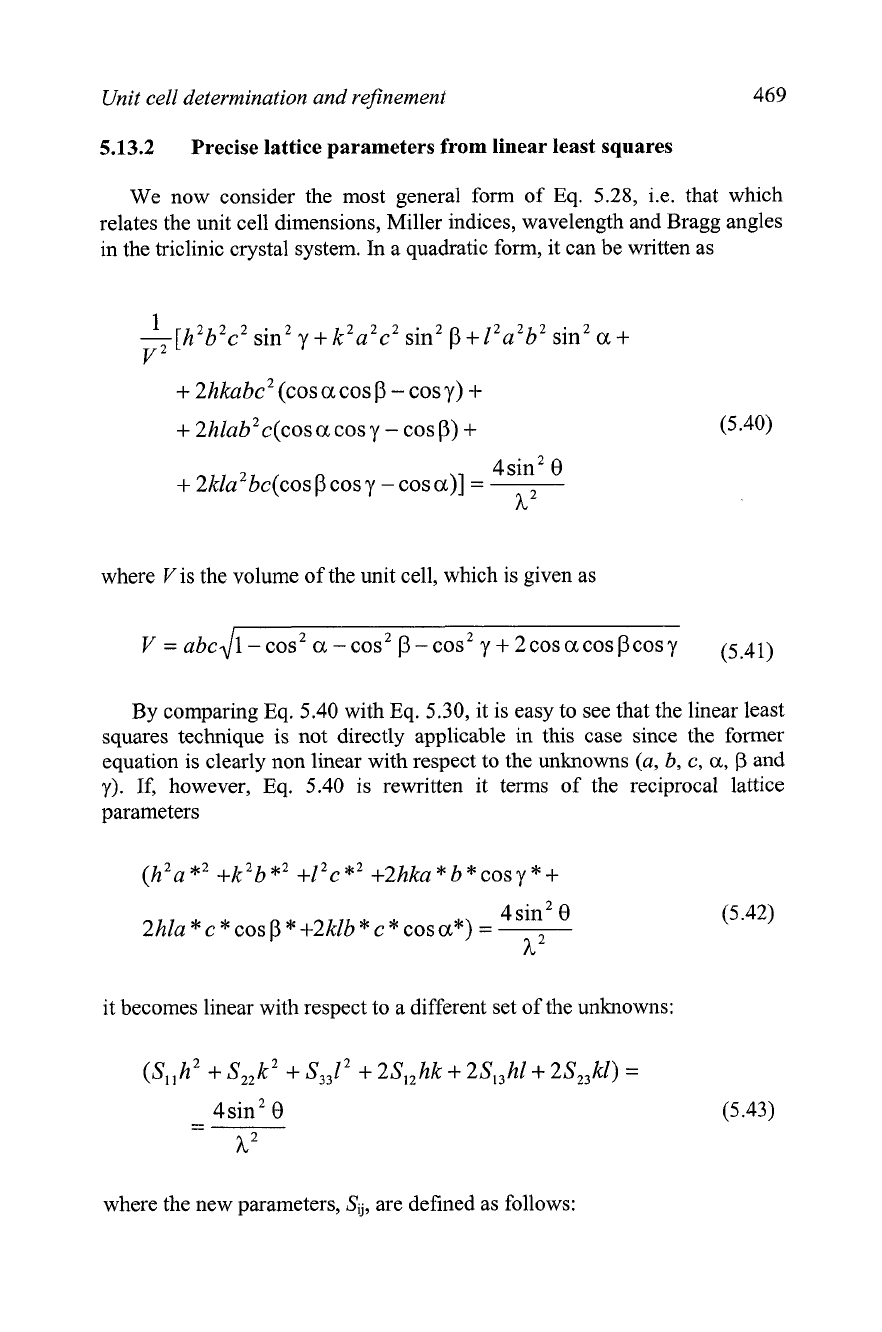
Unit cell determination and refinement
469
5.13.2
Precise lattice parameters from linear least squares
We now consider the most general form of Eq. 5.28, i.e. that which
relates the unit cell dimensions, Miller indices, wavelength and Bragg angles
in the triclinic crystal system. In a quadratic form, it can be written as
+
2hkabc2 (cos
a
cos
P
-
cosy)
+
+
2hlab2c(cosacos
y
-
cos
P)
+
4sin2
8
+
2kla 2bc(cos
P
cosy
-
cos
a)]
=
h
where
V
is the volume of the unit cell, which is given as
By comparing Eq. 5.40 with Eq. 5.30, it is easy to see that the linear least
squares technique is not directly applicable in this case since the former
equation is clearly non linear with respect to the unknowns (a,
b,
c,
a,
P
and
y).
If, however, Eq. 5.40 is rewritten it terms of the reciprocal lattice
parameters
(h2a
*2
+k2b
*'
+12c *2 +2hka
*
b
*
cos
y
*
+
it becomes linear with respect to a different set of the unknowns:
where the new parameters,
Si,
are defined as follows:

Chapter
5
S12 =a*b*cosy*=
abc2 (cos
a
cos
-
cosy)
v2
S13 =a*c*cosp*=
ab2c(cos a cosy
-
cosp)
v2
a
'bc(cos cos
y
-
cos
a)
S2,
=
b*c*cosa*=
v2
By comparing Eq. 5.43 with Eqs. 5.30 to
5.32
it is easy to see that matrix
A and vector
y
are constructed as follows:
and that the least squares solution according to
Eq.
5.39 results in a vector

Unit cell determination and refinement
from which the unit cell dimensions of the direct lattice are calculated using
Eq. 5.44.
So far, we considered the application of a liner least squares technique in
the case when no systematic error has been present in the observed powder
diffraction data. However, as we already know, in many cases the measured
Bragg angles are affected by a systematic sample displacement or zero shift
error. The first systematic error affects each data point differently and
considering Eq. 3.4 (section
3-53, when a sample displacement error,
s,
is
present in the data, Eq. 5.43 becomes
In
Eq. 5.48, R is the radius of the goniometer. The second systematic
error adds a small constant value,
600,
to each observed Bragg angle, which
results in the following equivalent of Eq. 5.43:
Both Eqs. 5.48 and 5.49 introduce one additional parameter in the least
squares refinement, i.e. sample displacement divided by the goniometer
radius,
SIR, or zero shift,
&go,
respectively. Regardless of the fact that the
contribution from both parameters is nonlinear, the linear least squares
technique can still be applied after the following simplifications.
From trigonometry, we know that
